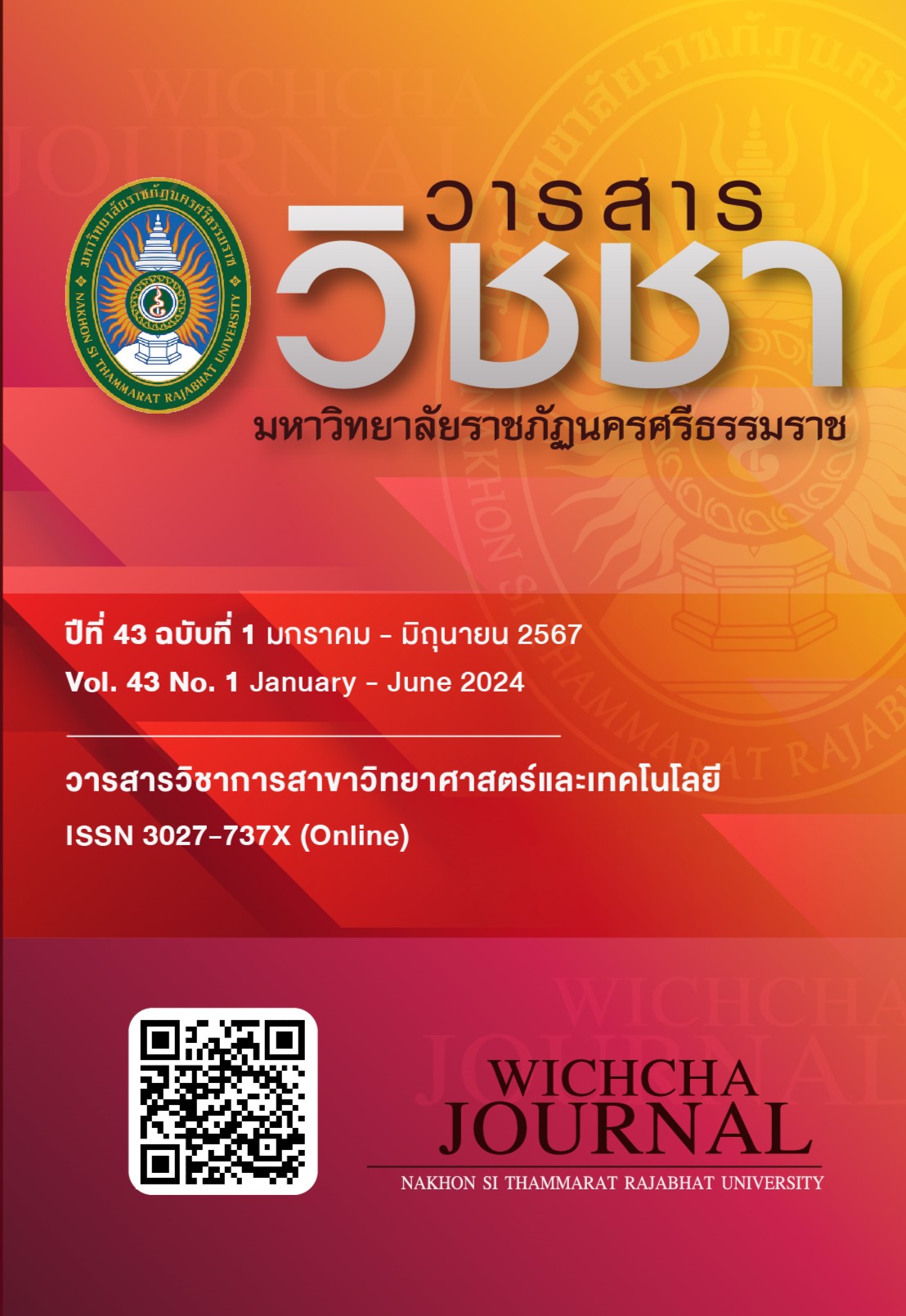Application of Marine Fish Processing Waste in Formulated Diet on Growth Performance and Fillet Chemical Composition of Asian Seabass (Lates calcarifer Bloch, 1790) Reared in Fresh Water
Main Article Content
Abstract
Marine fish processing waste contains high amount of nutritional values. The present study aimed to investigate the efficiency of marine fish processing waste in the formulated diets on growth performance, survival rate, fillet chemical compositions and feed cost of Asian seabass (Lates calcarifer Bloch, 1790) reared in fresh water. A completely randomized design was formulated comprising three experimental diets which included a diet containing dried form of marine fish processing waste and marine fish amino acids (T1), a diet containing dried form of marine fish processing waste (T2), and a commercial diet for marine fish (T3). The fingerling fish with initial body weight of 27-29 gram (g) were reared in fresh water cement tanks for four months. The results showed that the highest growth performances were found in T2 fish. The mean final weights, weight gain, and average daily gain of T2 fish were 385.7±12.0 g, 1,282.69±46.69%, and 2.98±0.09 g per fish per day, respectively. Also, the lowest feed cost per gain (41.09±3.98 baht per kilogram (kg)) was found in T2 fish. Whereas, T1 fish was found with the highest protein (85.47±1.57%) in the fillet but having the lower survival rate (83.30±3.30%) than T3 fish (93.30±3.30%). This study demonstrated that the dried form of marine fish processing waste can be used as a protein source in high protein diet for Asian seabass reared in fresh water.
Article Details

This work is licensed under a Creative Commons Attribution-NonCommercial-NoDerivatives 4.0 International License.
เนื้อหาและข้อมูลในบทความที่ลงตีพิมพ์ในวารสารวิชชา มหาวิทยาลัยราชภัฏนครศรีธรรมราช ถือเป็นข้อคิดเห็นและความรับผิดชอบของผู้เขียนบทความโดยตรง ซึ่งกองบรรณาธิการวารสารไม่จำเป็นต้องเห็นด้วยหรือร่วมรับผิดชอบใด ๆ
บทความ ข้อมูล เนื้อหา รูปภาพ ฯลฯ ที่ได้รับการตีพิมพ์ในวารสารวิชชา มหาวิทยาลัยราชภัฏนครศรีธรรมราช ถือเป็นลิขสิทธ์ของวารสารวิชชา มหาวิทยาลัยราชภัฏนครศรีธรรมราช หากบุคคลหรือหน่วยงานใดต้องการนำข้อมูลทั้งหมดหรือส่วนหนึ่งส่วนใดไปเผยแพร่ต่อหรือเพื่อการกระทำการใด ๆ จะต้องได้รับอนุญาตเป็นลายลักษณ์อักษรจากวารสารวิชชา มหาวิทยาลัยราชภัฏนครศรีธรรมราชก่อนเท่านั้น
The content and information in the article published in Wichcha journal Nakhon Si Thammarat Rajabhat University, It is the opinion and responsibility of the author of the article. The editorial journals do not need to agree. Or share any responsibility.
References
แจ่มจันทร์ เพชรศิริ ทวีเดช ไชยนาพงษ์ และธัญญา พันธ์ฤทธิ์ดำ. (2564). ประสิทธิภาพของเศษเหลือ จากการแปรรูปปลาดุกในสูตรอาหารสำเร็จรูปต่อการเลี้ยงปลาดุกลูกผสม (Clarias macrocephalus x C. gariepinus) ในกระชัง. วารสารวิชชา มหาวิทยาลัยราชภัฏนครศรีธรรมราช, 40(1), 16-30.
ชุติมา ตันติกิตติ สุภาพร มหันต์กิจ ไพรัตน์ โสภโณดร และอดุลย์ แมเร๊าะ. (2550). การใช้วัสดุเศษเหลือจากโรงงานอุตสาหกรรมแปรรูปสัตว์น้ำเป็นแหล่งโปรตีนทดแทนปลาป่นในอาหารปลากะพงขาว. วารสารสงขลานครินทร์ วทท., 29(5), 1321-1340.
พิเชต พลายเพชร ปิยารมณ์ คงขึม ธนิกานต์ บัวทอง และสกนธ์ แสงประดับ. (2562). การเสริมไลซีนและเมไทโอนีนในอาหารปลากะพงขาว กุ้งกุลาดำและกุ้งขาวแวนนาไม ระยะวัยรุ่นที่ใช้แหล่งโปรตีนทางเลือกในอัตราสูง. วารสารวิทยาศาสตร์บูรพา, 24(2), 867-884.
พิเชต พลายเพชร มนทกานติ ท้ามติ้น สิริพร ลือชัย ชัยกุล จีรรัตน์ เกื้อแก้ว เพ็ญศรี เมืองเยาว์ นงลักษณ์ สำราญราษฎร์ และสุพิศ ทองรอด. (2551). การเปรียบเทียบการเจริญเติบโตและคุณภาพเนื้อของปลากะพงขาว (Lates calcarifer Bloch, 1790) ที่เลี้ยงด้วยปลาสดและอาหารสำเร็จรูป. ใน การประชุมทางวิชาการของมหาวิทยาลัยเกษตรศาสตร์ ครั้งที่ 46. (หน้า 156-166). กรุงเทพฯ: มหาวิทยาลัยเกษตรศาสตร์.
วรรเพ็ญ คำมี จูอะดี พงศ์มณีรัตน์ และสมศักดิ์ จิระวัทโธ. (2555). ระดับโปรตีนและไขมันที่เหมาะสมในอาหารปลากะรังเสือ (Epinephelus fuscoguttatus Forsskal, 1775). เอกสารวิชาการฉบับที่ 32/2555. สำนักวิจัยและพัฒนาประมงชายฝั่ง, กรมประมง.
สุพันธ์ณี สุวรรณภักดี พัชราวลัย ศรียะศักดิ์ ณัทธิยา ชานาญค้า และพรพิมล พิมลรัตน์. (2564). ผลการใช้ไบโอฟลอคต่อการเจริญเติบโตและการควบคุมคุณภาพน้ำในการเลี้ยงปลากะพงขาวในน้ำจืด. วารสารวิทยาศาสตร์บูรพา, 26(1), 413-424.
AOAC. (2000). Official methods of analysis. (17th ed). Gaithersburg: The Association of Official Analytical Chemists.
Boonyaratpalin, M. (1997). Nutritional requirements of marine food fish cultured in Southeast Asia. Aquaculture, 151(1-4), 283-313, doi: https://doi.org/10.1016/S0044-8486(96)01497-4.
Caruso, G., Floris, R., Serangeli, C. and Paola, L.D. (2020). Fishery wastes as a yet undiscovered treasure from the sea: Biomolecules sources, extraction methods and valorization. Marine Drugs, 18(12), doi: https://doi.org/10.3390/md18120622.
De, D., Sandeep, K.P., Kumar, S., Raja, R.A., Mahalakshmi, P., Sivaramakrishnan, T., Ambasankar, A. and Vijayan, K.K. (2020). Effect of fish waste hydrolysate on growth, survival, health of Penaeus vannamei and plankton diversity in culture systems. Aquaculture, 524, doi: https://doi.org/10.1016/j.aquaculture.2020.735240.
Giri, N.A., Astuti, N.W.W., Sudewi, S., Marzuqi, M. and Asih, Y.N. (2021). Fish hydrolysate supplemented diet improved feed efficiency and growth of coral trout (Plectropomus leopardus). IOP Conference Series: Earth and Environmental Science, 890, doi: https://doi.org/10.1088/1755-1315/890/1/012024.
Harpaz, S., Hakim, Y., Slosman, T. and Eroldogan, O.T. (2005). Effects of adding salt to the diet of Asian seabass (Lates calcarifer) reared in fresh or salt water recirculating tanks, on growth and brush border enzyme activity. Aquaculture, 248(1-4), 315-324, doi: https://doi.org/10.1016/j.aquaculture.2005.03.007.
Madende, M. and Hayes, M. (2020). Fish by-product use as biostimulants: An overview of the current state of the art, including relevant legislation and regulations within the EU and USA. Molecules, 25(5), doi: https://doi.org/10.3390/molecules25051122.
Siddik, M.A.B, Howieson, J., Fotedar, R. and Partridge, G.J. (2021). Enzymatic fish protein hydrolysates in finfish aquaculture: A review. Reviews in Aquaculture, 13(1), 406-430, doi: https://doi.org/10.1111/raq.12481.
Williams, K.C., Barlow, C.G., Rodgers, L., Hockings, I., Agcopra, C. and Ruscoe, I. (2003). Asian seabass Lates calcarifer (Bloch) perform well when fed pelleted diets high in protein and lipid. Aquaculture, 225(1), 191-206, doi: https://doi.org/10.1016/S0044-8486(03)00278-3.


